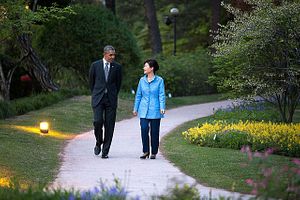I recently explored South Korean responses to the U.S. rebalance to Asia as part of the Seoul-based East Asia Institute’s project on South Korea’s middle power diplomacy. The project defines objectives for South Korean middle power diplomacy and makes recommendations for the South Korean government in the areas of trade, maritime security, climate change, development cooperation, and finance. The collection of papers provides recommendations and a template for evaluating the implications of a South Korea that is committed to playing a middle power role in regional and global affairs. My evaluation of South Korea’s aspirations to pursue middle power diplomacy is that to date these efforts have strengthened the U.S.-Korea alliance, but that in future there could be tensions on some issues between the alliance framework and South Korea’s aspirations to play a middle power role.
South Korea’s response to the U.S. rebalance thus far has been strongly supportive. South Koreans have regarded implementation of the rebalance strategy as credible, despite the overhang of sequestration; however, the credibility of the U.S. rebalance has probably owed more to the U.S. need to respond to North Korean threats than to the rebalancing strategy itself. The more challenging implications of the U.S. rebalance are related to increased U.S. expectations for South Korean cooperation with other U.S. allies and partners, especially in Southeast Asia but most notably including Japan.
The U.S. response to South Korean efforts to style itself as a middle power has been mixed. Some of South Korea’s middle power aspirations; for instance, the lessening of major power distrust and promotion of a norms–based regional order by strengthening cooperation in the areas of maritime security and by strengthening institutions are in sync; however, the United States has withheld its support for South Korea’s Northeast Asia Peace and Cooperation Initiative (NAPCI) and has not shown an interest in South Korea’s stepped up desire to play a “co-architect” role in regional institutions, in part because South Korea’s aspirations to do so seem so clearly to outstrip South Korea’s ability to deliver in practice.
South Korea’s desire and capability to fulfill its middle power aspirations may be framed by how Seoul handles its respective relations with Washington and Beijing. To the extent that the Sino-U.S. relationship is conflictual, such an environment will force South Korea to make undesirable choices. Those choices currently appear to be accumulating: both South Korea’s AIIB decision and its decisions on whether or not to allow the introduction to the peninsula of the Theater High Altitude Area Defense (THAAD) missile system will have a bearing on the future shape of global economic governance and the regional security environment, respectively.
Longer-term, South Korea also faces interesting decisions on whether to pursue Trans-Pacific Partnership and how to align its existing FTAs with the evolving China-ROK FTA. Most interesting, consequential, and potentially excruciating, however, will be South Korean decisions around the future shape of Korean reunification, many of which will involve choices between seemingly contradictory U.S. and Chinese preferences.
Scott A. Synder is Senior Fellow for Korea Studies and Director of the Program on U.S.-Korea Policy. This post appears courtesy of CFR.org and Forbes Asia.

































